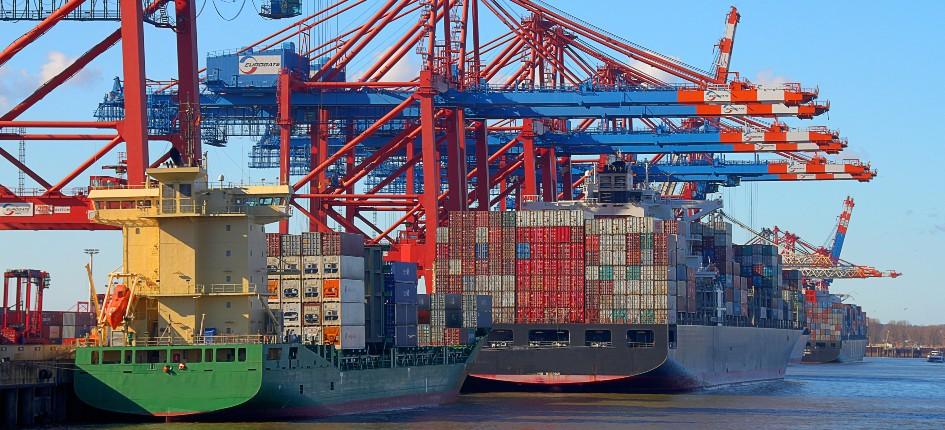Since the beginning of 2020, the world has been kept in check by the coronavirus pandemic. In the logistics world, this has led to an ongoing container shortage, among other things. Empty containers are left lying at the major seaports. For example, 160,000 empty TEU containers (twenty-foot equivalent unit/20-foot standard containers) in Yantian north of Hong Kong in June 2021, which is roughly equivalent to one day's throughput at Shanghai and Hamburg combined (annual throughput 2021: Shanghai 47 million, Hamburg 8.7 million TEU containers). This has already led to port congestion, delivery delays and massively increased freight costs. The current situation has also been exacerbated by the war in Ukraine, because energy prices for transportation are being driven up even higher.
Shanghai - Port congestion of historic scale
As the COVID-19 situation began to ease in many parts of the world in the spring of 2022, China was hit especially hard once again: As part of China's "zero-covid strategy", Shanghai's total lockdown from April 5 to May 31, 2022, has stalled the flow of goods around the world. After all, Shanghai is not only the largest seaport in the world, but also home to the Yangshan Deep-Water Port, the world's largest container port. The port facilities were not closed, but due to the stringent COVID-19 measures in the country, companies had to manage for a longer period of time with significantly fewer staff, some of whom were locked into the port area.
The functionality and capacity of the port was thus limited massively. As a result of this, there has been huge port congestion with up to 500 ships. Vast quantities of goods ready for export and import remained blocked on site. The situation has calmed down somewhat in the meantime. However, it is likely to take months for the situation to return to normal, and who knows what new challenges lie ahead.
Concentration of value as a dangerous accumulation risk
The immediate consequence of the last (for the time being) lockdown is still an immense concentration of value of unprecedented proportions in "Greater Shanghai". Whereas in "normal" times the insurance and reinsurance industry used to assume commodity values of few billion USD on a daily average, a low double-digit billion amount must now be expected. And this does not include the values of ships, port facilities, buildings or related consequential damage. It is hard to imagine the financial damage a severe typhoon or earthquake would cause in Shanghai or the surrounding area.
The greatest risk is therefore not only posed by natural hazards alone, but also by the interlinking of various circumstances: In 2003, the super typhoon "Maemi" raged over the land, one of the most severe cyclones in the history of South Korea. The damage to the Busan port facility alone was estimated at around USD 50 million at the time, and the cargo capacity was reduced by 20 %. The fact that the devastating storm was preceded by strikes for a long period of time as well as three public holidays caused the damage to increase even more due to the unusually high concentration of values. And this is not least because political risks such as strikes and unrest are often included in transport insurance policies.
Freight congestion and capacity bottlenecks outside Asia
However, the recent past has also shown that bottleneck situations are not limited to trading metropolises in Asia. Remember the container ship "Ever Given", which blocked the Suez Canal for six days in March 2021. The ship was refloated during an elaborate and time-consuming rescue operation. In the meantime, around 400 ships were blocked by the accident. All in all, the ongoing insurance settlement of the claim is expected to amount to around USD 2 billion. This makes "Ever Given" one of the most expensive claims in the long history of transport insurance.
Regardless of the various causes of the recent congestion of freight, the current developments must be closely monitored, analyzed and - also crucially - financed. As mentioned, normal operation is still a long way off. At the same time, demand for raw materials, newly manufactured goods and containers is picking up strongly again, and soon the pre-Christmas season will come to the fore, generating even higher volumes as well as risks. However, this boon for the economy also pushes the cargo ports in Europe and North America to their capacity limits. This is why there are often backlogs and longer waiting times on our doorstep.
Time to act - recommendations and practical tips
Each company must assess for itself what impact the described changes in the global economy and supply chains will have on its own business activities in order to re-plan resources around purchasing, distribution and logistics accordingly. However, a return to normality seems unlikely in the near future, and the situation is unlikely to calm down before spring 2023.
New solutions must therefore also be developed proactively in Switzerland in order to avoid raw materials, finished products or spare parts being blocked somewhere for a longer period of time, or only arriving in Switzerland or at their destination abroad with a long delay - and then possibly incomplete or damaged. The following measures and recommendations can help to break the status quo:
- Review sales contracts and Incoterms® 2020: Who organizes and pays for the transportation? Who bears the risk of loss and damage? To which party should any transport damage be paid? If logistical hurdles are difficult to overcome, transfer the risk to the foreign contract partner in order to cushion the negative effects of damage and trouble shooting.
- Recognize chokepoints: Which seaports or airports are the "congestion hotspots"? What are the reasons and what precautions should be taken?
- Evaluate new means of transportation, transport routes and possible detours: What is plan B? Evaluate the use of alternative routes and means of transport and test detour routes at an early stage.
- Talk to trading partners and carriers: Are the seaports, airports and transhipment warehouses involved fully staffed and operational? Are there operational inland transport routes, enough vehicles and enough experienced drivers for the route? Choose shore-based subcontractors yourself, including provision of the insurance certificate of the transport liability insurance with details of the sum insured. Insist on transparency and/or, if necessary, change the forwarder/carrier.
- Review the design and protection of goods: Are the demands placed on the goods different due to new transport routes and longer transportation times? If not within your direct control, check and provide instructions on how the goods are to be packed, transported and stored. Don't make false economies, so that you can ensure that damage can be prevented or recourse possibilities are available.
- Check your own transport insurance: Are the scope of cover and the sum insured adequate?
- Is a transfer of knowledge possible? Seek dialog with authorities, industry associations and your insurer. As a transport insurer, for example, we have a global network of specialized risk experts at our disposal.
Companies are facing challenges
Port congestion in many places around the world and the consequences thereof are likely to remain with us for some time. At the moment, Shanghai is still the place with the largest concentration of commodity values in the world. Those who transport goods there or via other chokepoints should, more than ever before, deal with the associated risks and alternative approaches. Further changes and new challenges are also foreseeable. All parties involved in the cross-border movement of goods are called upon to take the reins themselves when dealing with delivery delays and loss prevention, so that supply chains remain plannable and the goods arrive - as far as possible - at the intended time in an undamaged condition. And last but not least, active risk management can also have a positive impact on insurance premiums.




